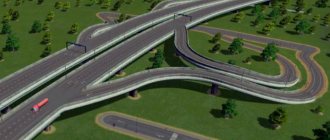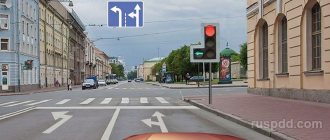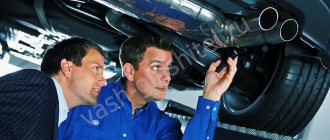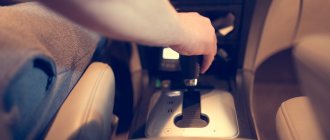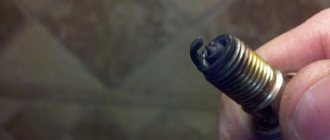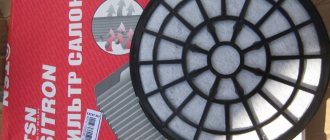To give the effect of a car moving quickly in a photograph, it is not necessary to accelerate to 100 km/h. In this simple tutorial I will tell you the technique of how to create photos with a car in motion.
You don't have to drive at high speed to achieve this effect in a photograph. By using your brain and being smart, you can achieve this effect in a fairly simple way, moving no faster than a pedestrian.
To do this, you will need a mounting device for the camera, which has legs with Velcro or suction cups, or at your own risk, place it on an ordinary tripod with rubber pads on the legs. The photo needs to be taken at a long shutter speed, thanks to which the car will remain clear and the background will be blurred, since only it will move relative to the camera.
First, you need to find a suitable place for shooting, where there will be no other cars, pedestrians or anything that will disturb you.
The road on which the car will drive must be very level and smooth. Any bump or unevenness will lead to camera displacement or an uneven, blurry background pattern.
For the best effect, you should think about choosing a location with the right background. I don’t think that shooting in a deserted field will give the beautiful desired effect. A dense forest or an underground parking lot with lighting on the walls and ceiling are suitable for shooting.
Now that you have found a location, let’s begin installing the camera. Professional photographers often use Manfrotto suction cups and clamps to secure the tripod to the car.
You can use a camera mount such as the Delkin Fat Gecko. Using it, the camera will be located at a height of 30cm from the car body. To take pictures, you need to use a wide-angle lens to capture the entire area of the car.
Exposition
When photographing a car in motion, use a shutter speed of around 1-4 seconds. The choice of shutter speed depends on the lighting of the shooting location. If the area around is very bright, you will have to use a short shutter speed of 1 second, or maybe less, which will give a weak blurring effect. Or you need to use a neutral density filter, which will help darken the picture and use longer shutter speeds. Close the aperture as much as possible so that it is larger than f/10. This will help increase the depth of field and reduce the flow of light to make the shutter speed longer. It is advisable to set ISO at a lower value, around 100, so that noise does not appear in the photo and there is not too much light. For shooting you need to use wide-angle lenses with a focal length of 10-20mm. For a cropped camera, you need to use a lens with a focal length of less than 17mm.
What is the distance between cars according to traffic rules in meters?
Everything related to road traffic is aimed at maintaining safety for its participants. This is how the distance between cars is established according to traffic rules in paragraph 9.10:
The driver must maintain such a distance from the vehicle in front that would allow him to avoid a collision, as well as the necessary lateral interval to ensure traffic safety.
That is, the Rules do not prescribe specific values for these distances in meters . After all, they depend on many factors:
- technical condition and characteristics of the vehicle;
- speeds, including those of neighboring vehicles;
- quality and other features of the road surface;
- traffic density;
- weather conditions, visibility;
- time of day;
- individual qualities of drivers (reaction speed, experience, etc.);
- other circumstances that may arise in a particular case.
What distance should be between cars? This is more of a technical problem. Ideally, under average conditions (non-slippery and level road, normal condition of the car, in the absence of the need to frequently and abruptly change the driving mode), it is advisable to maintain a distance equal to half the speed of the vehicle. But this number should not be in kilometers, but in meters.
That is, if the speed is 60 km/h, the distance is determined to be 30 m. Or you can take as a basis the average braking distance of cars, which, with the same value of the indicator, is 15 m. But all this, of course, is unrealistic. Such gaps will create more problems than benefits.
More on AutoLex.Net:
How to move at a T-shaped intersection: driving rules and penalties for violation, driving through an unregulated intersection of equivalent roads, with a traffic light
There is another, more adequate rule that allows you to calculate the correct distance between driving cars. It must be such that if emergency braking is necessary, a collision will not occur. That is, after pressing the pedal, the driver must have at least 2 seconds left to cover the distance to the next car.
When driving around the city
In a populated area, traffic conditions can also be different. Sometimes these are traffic jams in which it is impossible to maintain too great a distance, but it is also dangerous to get close to neighboring vehicles. In other cases, it is possible to drive at a good speed without changing the mode suddenly.
Taking all this into account, the distance between cars in the city is advisable to be 2/3 of the length of the vehicle body. On average it is 3 meters. If the driver is experienced, with good reaction, it is permissible to reduce it to 2. But you need to take into account that another motorist may be less agile, and other factors affecting safety should not be overlooked. If the road is slippery, the tires are “bald”, and there is a whole chain of other cars ahead, this distance should be increased to 4 meters.
In bad weather or in icy conditions or heavy rain, the gap between cars should be stretched so that the braking distance is shorter than the field of view. This rule must be followed without reservation on narrow streets, sharp turns and intersections with reduced visibility.
When leaving the highway
Outside the populated area, the permissible speed of cars is higher than within its boundaries. This alone is a sufficient reason to increase the distance from one vehicle to another. To a greater extent, the distance on the highway between cars is determined by the characteristics of the road surface. It should be such that:
on clean and dry asphalt, the driver had 2 seconds to cover the distance to the vehicle in front;
- under the same conditions, but in the dark, there were 3 seconds left;
- the same amount of time remained if the road was wet or had small potholes;
- During the day, on a slightly snowy road, it was possible to reach the car ahead in no less than 4 seconds;
- under the same conditions, but in the dark there were 5 of them;
- if the snow is dense or there are patches of ice, the driver has 5 seconds at his disposal;
- in case of ice, snow “porridge”, heavy rain, the distance to the vehicle in front was maintained and covered in at least 6 seconds.
More on AutoLex.Net:
How to behave correctly on the road if cars are driving with special signals
That is, the more difficult the conditions, the greater the distance between cars should be when driving. Do not forget about mandatory compliance with subsection 9.11 of the traffic rules:
Outside populated areas on dual carriageway roads with two lanes, the driver of a vehicle for which a speed limit has been established, as well as the driver of a vehicle (vehicle combination) longer than 7 m, must maintain such a distance between himself and the vehicle moving ahead that overtaking vehicles could move into the lane they previously occupied without interference.
This requirement does not apply when driving on sections of roads where overtaking is prohibited, as well as during heavy traffic and movement in an organized transport convoy.
At the traffic light
While waiting for a traffic light to allow you to continue moving, cars usually stand quite close to each other. And this can provoke a collision, because here someone changes the driving trajectory. And too large a distance can lead to another car trying to slip into the resulting space.
The distance between cars at a traffic light should be chosen so as to avoid these difficulties and leave the opportunity to go around a stalled vehicle without using reverse gear. That is, 2-3 meters will be enough. In case of danger, such a gap will also leave a chance to quickly change lanes.
As part of the column
An organized chain of cars is formed in accordance with special rules. During movement, all maneuvers of vehicles traveling in a convoy are performed in coordination. The speed of each of them should be the same as the leading one. And, in accordance with paragraph 9.11 of the traffic rules, cars in a convoy are not required to leave gaps to allow other vehicles to overtake them.
However, the distance between vehicles in a convoy should ensure safety in the event of sudden braking. Theoretically, it is selected at the rate of 1 meter per 1 km/h speed. In practice, such gaps will lead to the stretching of the chain of cars over a huge distance, creating inconvenience for other road users.
More on AutoLex.Net:
Basic traffic warning signs
Therefore, it is more advisable to choose the distance based on the body size of the longest car, as well as speed and road conditions:
- if the column moves up to 40 km/h, the distance between cars can be from 8 m;
- 40-60 km/h – 11-12 m when in a populated area;
- 60-80 km/h – 15 m if driving on the highway;
- over 80 km/h – 20-25 m.
But in all cases, the gaps between cars must leave room for sudden maneuvers without the threat of a collision.
In a traffic jam"
When driving in a traffic jam, the speed of the vehicle is usually minimal, so the braking distance is shortened if a sudden stop is necessary. And the distance between cars in such conditions is permissible at half the length of the body, if the driver is sufficiently experienced. This is approximately 2 meters. For beginners, it is better to choose 2/3 of this value, that is, an average of 3 meters. This is enough to change lanes to the next lane if the car ahead stalls.
The distance between cars according to traffic rules in meters should be set for reasons of expediency by the driver himself. There cannot be a single indicator for all cars and road conditions. The main selection criteria are safety, the ability to perform maneuvers and emergency braking without the risk of crashing into the vehicle in front.
Time to shoot
After installing and configuring the equipment, you can begin the shooting itself. The driver should start and drive smoothly and at low speed while you are filming. The driver himself must not move his head and body so as not to appear blurry in the photo. To be on the safe side, it is better to be near the car, in case the suction cups come off or the camera falls. If you forget, wipe the surface of the car so that there is no streaks or dust on the surface of the car in the photo.
Simulation of car movement and skidding in a JavaScript game
It was necessary to write a game in JavaScript. I decided to stick to primitive racing. When I mastered the principles of rotation and movement in HTML5 Canvas, the next problem arose: driving a car. While making this game, I remembered the game Grand Prix Simulator 2 ZX Spectrum, which I played on the Byte computer. The management there was as follows:
- up arrow: gas;
- left arrow: rotate counterclockwise;
- Right Arrow: Rotate clockwise.
It was easy to implement: the machine has a direction in radians, and when a button is pressed, the rotateLeft or rotateRight event is called.
These methods simply add or subtract a constant angle change value from the direction of the car. But in that game the car also had a skid (it’s inconvenient at first, but it’s more interesting). And I decided to write some kind of skid emulation. Essentially, a skid occurs when the car itself changes direction, but its movement does not change direction along with it. How accurately do you need to reproduce the movement from a physics point of view? My goal was to make a skid that would look like a real one.
First you need to separate the speed vector and direction of the car:
this.carDirection - angle that specifies the orientation of the car; this.linearVelocity is the velocity vector specified in Cartesian coordinates.
Next, we attach the event of changing the orientation of the car to the rotation keys. When it differs from the direction of the velocity vector, it begins to turn in the direction of the car. The rotation speed of this vector is set by the empirical coefficient SMOOTHING.
So, the car took off. Now we need to check whether the pilot stayed on the track. The route is a broken line, sections of which have a certain width. These lines on the route are at some angle. Thus, the problem is formulated as follows: you need to check whether a point falls into a rectangle located at some angle. One way would be to transfer the coordinate system to a section of the route so that this section of the route lies on one of the axes. To do this, you need to subtract the coordinates of the beginning of the segment from the car coordinates, and then multiply them by the rotation matrix:
function turnAndTranslate(lineIndex, position) { return [ trace[lineIndex].cos * (position[0] - trace[lineIndex].begin[0]) + trace[lineIndex].sin * (position[1] - trace[lineIndex ].begin[1]), trace[lineIndex].sin * (- position[0] + trace[lineIndex].begin[0]) + trace[lineIndex].cos * (position[1] - trace[lineIndex] .begin[1]) ]; }
For the rotation matrix, multiply the coordinate vector by a matrix that contains the sine and cosine of the rotation angle. In order not to calculate trigonometric functions during each check, they are calculated only once when initializing the map and are stored as coefficients for each segment of the trace.
The program is somewhat crude, but you can already ride here.
EXAMPLES OF TASKS
Part 1
1. What is the projection of the speed of a uniformly moving car if the projection of its displacement in 4 s is 80 m?
1) 320 m/s 2) 80 m/s 3) 20 m/s 4) 0.05 m/s
2. What is the modulus of displacement of a fly in 0.5 min if it flies at a speed of 5 m/s?
1) 0.25 m 2) 6 m 3) 10 m 4) 150 m
3. A Renault car travels in 1 minute. the path is 1.2 km. A Peugeot car travels 0.2 km in 20 seconds. Compare the values of the Renault speed - \( v_1 \) and the Peugeot speed - \( v_2 \).
1) \( v_1=v_2 \) 2) \( v_1=2v_2 \) 3) \( 2v_1=v_2 \) 4) \( 1.2v_1=10v_2 \)
4. The figure shows a bar graph. It shows the distance values that, with uniform movement, a fly (1) and a sparrow (2) fly in the same time. Compare their speeds \( v_1 \) and \( v_2 \).
1) \( v_1=v_2 \) 2) \( v_1=2v_2 \) 3) \( 3v_1=v_2 \) 4) \( 2v_1=v_2 \)
5. The figure shows a graph of the dependence of the speed modulus of uniform motion on time. The modulus of body displacement in 2 s is equal to
1) 20 m 2) 40 m 3) 80 m 4) 160 m
6. The figure shows a graph of the path traveled by a body during uniform motion as a function of time. The modulus of the body's velocity is equal to
1) 0.1 m/s 2) 10 m/s 3) 20 m/s 4) 40 m/s
7. The figure shows graphs of the path versus time for three bodies. Compare the speed values \( v_1 \), \( v_2 \) and \( v_3 \) of the motion of these bodies.
1) \( v_1=v_2=v_3 \) 2) \( v_1>v_2>v_3 \) 3) \( v_1 4) \( v_1=v_2 \), \( v_3
8. Which of the following graphs represents a graph of path versus time for a body in uniform motion?
9. The figure shows a graph of the body coordinates versus time. What is the coordinate of the body at time 6 s?
1) 9.8 m 2) 6 m 3) 4 m 4) 2 m
10. The equation of motion of the body corresponding to the graph given in problem 9 has the form
1) \( x=1t \) (m) 2) \( x=2+3t \) (m) 3) \( x=2-1t \) (m) 4) \( x=4+ 2t\)(m)
11. Establish a correspondence between the quantities in the left column and the dependence of the value of the quantity on the choice of the reference system in the right column. In the table, under the number of the knowledge element in the left column, write down the corresponding number of the element of your choice in the right column.
QUANTITY A) displacement B) time B) speed
DEPENDENCE ON THE CHOICE OF REFERENCE SYSTEM 1) depends 2) does not depend
12. The figure shows a graph of the body coordinates versus time. What conclusions can be drawn from analyzing the graph? Please indicate two correct answers.
1) the body was moving all the time in one direction 2) for four seconds the module of the body’s velocity decreased and then increased 3) the projection of the body’s velocity was positive all the time 4) the projection of the body’s velocity was positive for four seconds and then negative 5) at time 4 s the body stopped
Part 2
13. Two cars move behind each other uniformly and in a straight line: one at a speed of 20 m/s, the other at a speed of 15 m/s. How long will it take for the second car to catch up with the first one, if at the initial moment of time the distance between them is 100 m?
Distance between cars
When you move closely behind a car, you are deprived, one might say, of a certain degree of freedom of action:
- you deprive yourself of proper review;
- You deprive yourself of the opportunity to make a detour if the car ahead has stopped for some reason. It is not always possible to reverse; usually your car is also “propped up”;
- you will not be able to accelerate to perform the maneuver;
- you will not be able to resort to braking in an emergency, or indeed to braking safely, because you do not leave yourself any room to stop.
Therefore, while driving in traffic, try to keep a distance from the car in front that will allow you to stop your car without changing lanes and avoid a collision with the one in front of you.
When driving in traffic, as experienced drivers recommend, it is more convenient to calculate the distance between cars not in meters, but in seconds. Why in seconds?
Firstly, the eye of all people is different and when the speed changes, the distance in meters will always change. And counting seconds of movement is easier for a person than determining meters by eye. Secondly, the distance in seconds always remains the same at any speed.
Therefore, a safe distance can be considered such a distance when the time to reach the place where the car in front was just located is 2-3 seconds on dry asphalt. On a slippery road, the safe distance should be increased to 4-5 seconds.
From this rule we can conclude that the distance between cars should be greater than:
- higher driving speed;
- worse condition of the road surface and worse visibility;
- The view of the road is more limited by obstacles, stationary or moving vehicles.
One more thing. Moving in traffic along your lane, you will have to stop periodically, for example, at traffic lights, during random traffic jams, or, even worse, in traffic jams. During such stops, you should not press close to the car in front. You need to leave yourself room to maneuver.
It may happen that the car in front of you will not be able to continue moving (it will stall, break down, etc.) and you will need to go around it. If you drive close to it, then in order to go around you will have to back up. And another car may “support” you from behind. So at what distance is it best to stop or how far away from reaching the “front” car?
The reference point in this case can be the “spot” of contact between the rear wheels of the “front” car and the road. In other words, when approaching a car that has stopped in front of you, look at its rear wheels. As you approach it, your hood will begin to block your view.
First, the rear wheels will disappear from view, and when you get very close, the rear bumper will disappear. Try to stop so that the rear wheels and the “spot” of their contact with the road are completely visible to you. In this case, you can easily drive around the car that has stopped in front of you without backing up.
